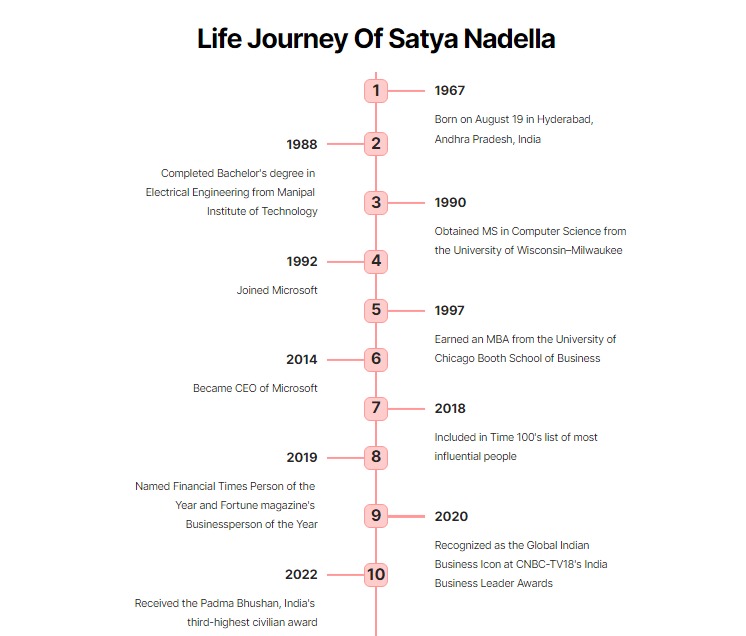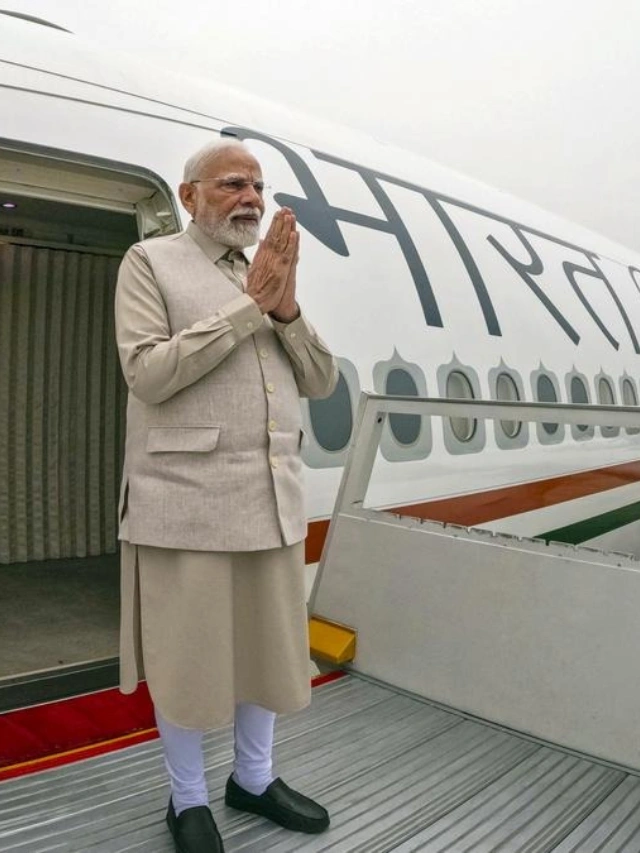Satya Nadella
Satya Nadella has turned Microsoft from a struggling tech giant into a $3.2 trillion market leader since becoming CEO in 2014. His rise to the top of the technology world stands as one of the most remarkable success stories in modern business. Born in Hyderabad, India, on August 19, 1967, Nadella’s leadership has driven Microsoft’s stock up nearly tenfold with a 27% annual growth rate that shows his extraordinary effect on the company.
Nadella’s strong educational background prepared him for his future role. He completed his bachelor’s degree in electrical engineering from the Manipal Institute of Technology in 1988. A master’s degree in computer science from the University of Wisconsin-Milwaukee followed in 1990. His academic pursuit culminated with an MBA from the University of Chicago in 1997. These credentials equipped him with the technical and business expertise needed for the challenges ahead.
CEO’s | Actors | Politicians | Sports Stars
Nadella’s emphasis on empathy and cultural transformation sets his leadership apart. Fortune magazine ranked him #3 on their list of 100 Most Powerful People in Business in November 2024, recognizing him as a “charismatic and empathetic leader.” His leadership philosophy draws deeply from personal experiences, including the loss of his son Zain who had cerebral palsy. His early passion for cricket also helped develop skills that enhanced his corporate leadership approach.

Early Life and Education
Satya Nadella’s birth place and family background
Hyderabad Origins: Satya Nadella was born on August 19, 1967, in Hyderabad, India, to a Telugu Hindu family. His parents’ diverse careers and viewpoints shaped his intellectual growth. His father, Bukkapuram Nadella Yugandhar, worked as an economist and served as an Indian Administrative Service officer of the 1962 batch. His mother, Prabhavati, brought ancient Indian literature and philosophy into their home as a Sanskrit lecturer.
Family Influence: Young Satya grew up in an environment created by his parents’ contrasting personalities and professions. “My parents played a massive role in who I am today. My father was a civil servant, an economist, and my mother was a Sanskrit professor. They were exact opposites of each other in some sense, they could not agree on anything, except giving me lots of room and a lot of confidence to become my own person, pursue my own passions,” Nadella recalled. His father’s ancestral roots came from Bukkapuram in Anantapur district of Andhra Pradesh. The family had moved there from Nadella village in Guntur district (now Palnadu district).
Middle-Class Values: Life in a middle-class Indian household came with its share of challenges. “Growing up middle class in India, that sort of sometimes is challenging,” Nadella has acknowledged. All the same, this background helped him develop resilience and determination that would benefit his career.
Schooling and early interests
Educational Foundation: The prestigious Hyderabad Public School in Begumpet laid the groundwork for Nadella’s education. Many of India’s future leaders emerged from this institution. The school gave him a strong academic foundation and nurtured his budding interests in technology and sports.
Technological Fascination: Computers and technology captured Nadella’s imagination during his school years. “One of the interesting things I distinctly remember is American technology. I remember the first I started using a computer. It was the malleability of software that got me hooked,” he shared. He adds, “I won’t say that I was like those people who took it and said ‘That’s my future’ but it was there, it was latent”.
Cricket Passion: Cricket became more than just a sport for Nadella in his formative years. The game shaped his leadership philosophy and taught him valuable team-building skills that he carried into his corporate career. His love for cricket stayed with him even after moving to the United States.
Satya Nadella education qualification and degrees
Engineering Foundation: Nadella reached a crucial point in his educational path after finishing school. He couldn’t clear the IIT entrance examinations in his first try and had to choose between Birla Institute of Science and Technology (BITS) Mesra and Mangalore University (now Manipal Institute of Technology). He chose the latter and completed his Bachelor’s degree in Electrical Engineering in 1988. This choice set him on a path to remarkable success.
American Education: Nadella moved to the United States after his undergraduate studies. He earned his Master’s degree in Computer Science from the University of Wisconsin–Milwaukee in 1990. The program enhanced his expertise in computer systems, algorithms, and software design—knowledge that became crucial for his future career.
Business Acumen: Nadella understood the value of combining technical skills with business knowledge. He earned an MBA from the University of Chicago Booth School of Business while working, graduating in 1997. Educational analysts note, “When he felt the need of having leadership qualifications to progress further in his career, he pursued an MBA degree along with his job. This gave him an outlet from the traditional Engineering, giving him a break at the Vice President’s position in a department of the organization”. His MBA gave him essential management, strategy, and decision-making skills that complemented his technical background.
Educational Philosophy: Nadella’s career shows his commitment to continuous learning. His progression from electrical engineering to computer science to business administration reveals a systematic approach to skill development. This dedication to lifelong learning became the life-blood of the cultural transformation he brought to Microsoft, where he promoted a “growth mindset” throughout the organization.
Career Beginnings and Rise at Microsoft
First job at Sun Microsystems
Technology Staff Member: Satya Nadella started his professional experience at Sun Microsystems after completing his master’s degree in computer science. Sun Microsystems was one of the most innovative tech companies at that time. His role as a technology staff member gave him valuable experience in the fast-moving computing industry. Some sources suggest he worked on developing technology for Sun’s first Java Virtual Machine (JVM), though this information comes from a less reliable source. His brief time at Sun gave him foundational experience that proved valuable later.
Transition Period: Nadella showed great promise during his time at Sun Microsystems, and his attention was drawn to new chances elsewhere. This time served as a vital stepping stone in his career growth. He gained exposure to innovative technology and industry practices. A different opportunity soon came up that ended up shaping his career path for decades.
Joining Microsoft in 1992
Career-Defining Move: Nadella made a life-changing decision to join Microsoft in 1992. Bill Gates was still CEO then, and Windows had just started its path toward market dominance. He worked on Windows NT development, a groundbreaking operating system we aimed at business users. “I remember distinctly walking into building 22 at Microsoft in 1992 thinking that’s the greatest job on earth I have and I don’t need anything more,” Nadella recalled in an interview with LinkedIn CEO Ryan Roslansky.
Early Projects: Nadella’s early days at Microsoft involved work on the company’s interactive TV product alongside Windows NT operating system. These projects showed his technical skills and adaptability. He gained a detailed understanding of Microsoft’s technological ecosystem through this work.
Dedication to Growth: Nadella’s exceptional commitment to professional growth impressed his colleagues and managers in his early years. He commuted every weekend from Microsoft’s Redmond, Washington campus to Chicago to complete his MBA. This dedication to education while working full-time showed his extraordinary work ethic and drive to advance his knowledge and career.
Key roles before becoming CEO
Ascending the Corporate Ladder: Nadella’s Microsoft career saw steady growth through increasingly important leadership positions. He became vice president of the new Microsoft Central in 1999, which offered web services for small businesses. Steve Ballmer became Microsoft’s second CEO in 2000, and Nadella moved up to corporate vice president of Microsoft Business Solutions in 2001.
Expanding Responsibilities: The 2000s saw Nadella take on bigger leadership roles in Microsoft divisions:
- Senior Vice President of Research and Development for Online Services Division (2007-2011)
- President of Server & Tools Division (2011-2014)
- Executive Vice President of Cloud and Enterprise group
Transformational Leadership: Nadella led the Server and Tools Business to generate about INR 1603.23 billion in yearly revenue. The division changed from client services to cloud infrastructure and services under his leadership. He built one of the world’s largest cloud infrastructures and brought Microsoft’s database, Windows Server, and developer tools to its Azure cloud platform. Cloud Services revenue grew from INR 1400.72 billion in 2011 to INR 1712.92 billion by June 2013 under his watch.
Strategic Vision: Nadella consistently showed exceptional tech insight and business sense before becoming CEO. His knowledge of both technical and commercial aspects of computing made him an increasingly valuable leader at Microsoft. His success in leading the Server and Tools Business and Cloud and Enterprise division—especially his key role in Microsoft’s move toward cloud computing—made him a strong candidate for the company’s top position.
Becoming Microsoft CEO and Transforming the Company
Satya Nadella appointed as CEO in 2014
Historic Appointment: Microsoft’s Board of Directors made a unanimous decision to appoint Satya Nadella as the company’s third Chief Executive Officer on February 4, 2014. He followed in the footsteps of Bill Gates and Steve Ballmer. The board selected the 46-year-old Nadella after a five-month search that looked at some of the world’s most renowned executives. Bill Gates expressed his confidence saying, “During this time of transformation, there is no better person to lead Microsoft than Satya Nadella.” He praised Nadella’s combination of engineering expertise, business vision, and leadership skills.
Leadership Transition: Nadella joined Microsoft’s Board of Directors when he became CEO. The leadership restructuring brought more changes as Bill Gates stepped into a new role as Founder and Technology Advisor, while John Thompson took over as Chairman. Nadella showed his gratitude and vision: “I couldn’t be more honored to have been chosen to lead the company.” He added that Microsoft had huge opportunities ahead, but success would require clear focus, faster action, and continued transformation.
Major acquisitions under his leadership
Strategic Expansion: Nadella led Microsoft through 326 acquisitions worth over INR 14344.68 billion. The buying spree started in 2014 with Mojang, the creator of Minecraft, for INR 210.95 billion. Microsoft then acquired LinkedIn in 2016 for INR 2210.77 billion, GitHub in 2018 for INR 632.85 billion, and completed its biggest deal yet with Activision Blizzard.
Business Transformation: These strategic purchases expanded Microsoft’s reach into gaming, professional networking, and developer communities. Each acquisition brought fresh audiences to Microsoft’s ecosystem, strengthening the company’s position in the digital world.
Cultural shift and growth mindset
Mindset Revolution: Nadella transformed Microsoft’s culture from a “know-it-all” fixed mindset to a “learn-it-all” growth mindset. Microsoft’s Chief People Officer noted with humor: “We always joke, the minute you think you’ve arrived and have a growth mindset is the minute you have a fixed mindset”. This new approach valued continuous learning over assumed brilliance. Nadella often reminded everyone that “the learn-it-all does better than the know-it-all”.
Collaborative Environment: Microsoft’s departments once operated in isolation, with employees locked in internal political battles. Nadella’s cultural changes encouraged agility, state-of-the-art solutions, and teamwork both inside and outside the company. The company welcomed open-source development and became a Platinum member of the Linux Foundation in 2016.
Microsoft’s cloud and AI expansion
Cloud Dominance: Nadella steered Microsoft from a Windows-first approach to cloud-first priorities. Microsoft Cloud now generates INR 2784.55 billion in quarterly revenue. The service has become essential for business, with 95% of Fortune 500 companies using Azure cloud services.
AI Investment: Nadella revealed plans to invest INR 253.14 billion in cloud and AI infrastructure in India over two years in January 2024. This announcement built on earlier commitments, including INR 84.38 billion to OpenAI in 2019 and a later INR 843.80 billion investment to strengthen their AI leadership. “We’ve moved from talking about AI to applying AI at scale,” Nadella said, highlighting Microsoft’s success in attracting new customers and boosting productivity across industries.
Leadership Style and Core Values
Empathy as a leadership trait
Transformative View: Satya Nadella challenges the common belief that empathy is a “soft skill.” He calls it “the hardest skill we learn.” His son’s cerebral palsy shaped this view deeply. “For multiple years I struggled with it: Why did this happen to me? Why were my plans thrown out the window?” he shared openly. The realization came to him: “Nothing happened to me; something happened to Zain. And I had to step up and be the parent and the father”.
Innovation Driver: Nadella believes empathy propels business innovation by helping leaders spot customers’ hidden needs. “Innovation is about meeting the unmet unarticulated needs of customers. What’s the source of it? You could say it’s design thinking, but design thinking is empathy”. Microsoft’s culture changed significantly under his leadership. Teams noticed that “There’s this feeling of empathy among teams now to try to make each other successful, instead of so much internal competition”.
Creating clarity and energy
Clarity Champion: Nadella sees creating clarity amid uncertainty as his key leadership principle. “The most important attribute that any leader needs to have—and it is often underestimated—is the need to create clarity when none exists”. He explains, “You don’t need a leader when everything is well-defined… But in an ambiguous situation, where there cannot be complete information, that is when leadership will matter”.
Energy Generator: The second pillar of Nadella’s leadership centers on creating energy throughout an organization. “There is no simple thing that is always under your control, so the idea that you have got to create energy all around you is another element”. His belief that “In the long run EQ trumps IQ” shows that leaders must generate energy to achieve meaningful change.
Driving success in constrained environments
Constraint Navigator: Nadella’s third core leadership element focuses on achieving success despite limitations. “Life is an overconstraint problem. So you can’t say, ‘You know what? I’m just waiting for you to remove all the constraints and I’ll be perfect'”. He dismisses leaders who point to external factors for poor results, stating “Everything is exogenous”.
Growth Mindset: Nadella has changed Microsoft from a “know-it-all” to a “learn-it-all” company. This approach draws from psychologist Carol Dweck’s research, suggesting that people with less natural talent can achieve more through continuous learning. “That applies to CEOs and companies too,” Nadella points out.
Personal Life and Legacy
Remarkable Transformation
Satya Nadella has turned Microsoft from a struggling tech giant into a $3.2 trillion market leader. His trip from Hyderabad to becoming Microsoft’s third CEO is proof of his remarkable vision and leadership skills. Microsoft stock has grown nearly tenfold under his guidance, showing a stunning 27% annual growth rate. These numbers definitely confirm his strategic decisions. His focus on cloud computing and AI technologies has made Microsoft a pioneer in technological breakthroughs.
Work–Life Balance
Satya Nadella, married since 1992 to Anupama Priyadarshini, his junior in architecture school. The couple raised three children: a son, Zain, who was born with cerebral palsy and tragically passed away in February 2022 at age 26, and two daughters, Tara and Divya. Personal challenges deeply influenced Nadella’s empathetic leadership; he credits fatherhood of a child with special needs as a defining moment (especially explored in his memoir Hit Refresh). Despite his demanding role at Microsoft, Nadella prioritizes home life: he typically limits work to 7–9 hours a day, helps his children with homework, joins family dinners with Anupama, reads poetry in the evenings, and aims for sufficient rest.
Cultural Architect
Nadella’s most enduring contribution comes from his complete reimagining of Microsoft’s corporate culture. The company’s move from a “know-it-all” to a “learn-it-all” organization has rejuvenated its innovative spirit and collaborative potential. Teams that once worked in isolation now collaborate seamlessly. The company accepts new ideas, embraces open-source development, and builds partnerships that seemed impossible before. This cultural transformation stands as his most important achievement—one that will shape Microsoft’s future long after he leaves.
Leadership Philosophy
Leaders in any discipline can learn from Nadella’s leadership philosophy, which centers on empathy, creating clarity, and succeeding despite limitations. His life experiences, especially raising a son with cerebral palsy, taught him that empathy drives innovation rather than being just a “soft skill.” He knows how to create clarity in uncertain times while energizing the entire organization. This shows his emotional intelligence matches his technical expertise. So, his approach shows how to lead effectively when things change faster than ever.
Key Takeaways
Nadella’s path from a cricket-loving student to a transformative CEO reveals how his education, career growth, and personal experiences shaped his leadership approach. His strategic acquisitions—from LinkedIn to GitHub to Activision Blizzard—have expanded Microsoft’s portfolio and strengthened its market position. The company’s investments in cloud infrastructure and artificial intelligence have secured its place in emerging technologies. Nadella’s legacy will be remembered not just for growing profits but for reimagining Microsoft’s role in the 21st century.
Satya Nadella Timeline Chart:

Also Read: Journey of Ratan Tata, Yamini Rangan
FAQ:
What is Satya Nadella’s educational background?
Satya Nadella earned a Bachelor’s degree in Electrical Engineering from Manipal Institute of Technology, a Master’s degree in Computer Science from the University of Wisconsin–Milwaukee, and an MBA from the University of Chicago Booth School of Business.
What is Satya Nadella’s estimated net worth?
Satya Nadella’s net worth is estimated at around $320 million.
How much does Satya Nadella earn from Microsoft?
Satya Nadella’s total annual compensation has been reported at approximately $79 million in recent years.
Does Satya Nadella have children?
Satya Nadella had three children—two daughters and a son, Zain, who sadly passed away in 2022.
How old is Satya Nadella?
Satya Nadella was born on 19 August 1967 and is 57 years old as of 2025.
Who is Satya Nadella’s wife?
Satya Nadella is married to Anupama Priyadarshini, whom he married in 1992. Anupama was his junior at Manipal Institute of Technology, where she studied architecture.
Has Satya Nadella written a book?
Satya Nadella authored the book Hit Refresh, which was published in 2017.
How tall is Satya Nadella?
Satya Nadella’s height is reported between 5 feet 7 inches and 5 feet 9 inches.
What is Satya Nadella’s religious background?
Satya Nadella was born into a Hindu family.
What is Satya Nadella’s nationality?
Satya Nadella is Indian-born and now holds American citizenship.




